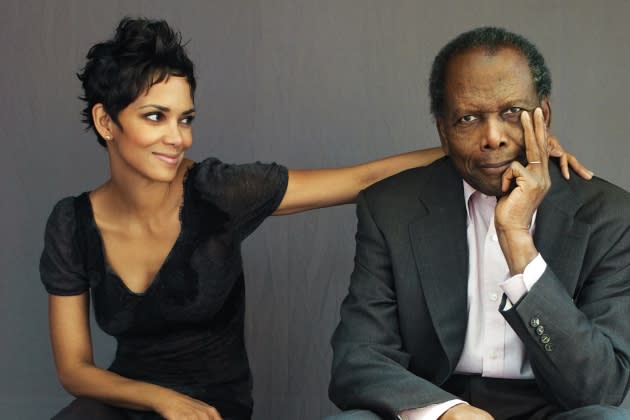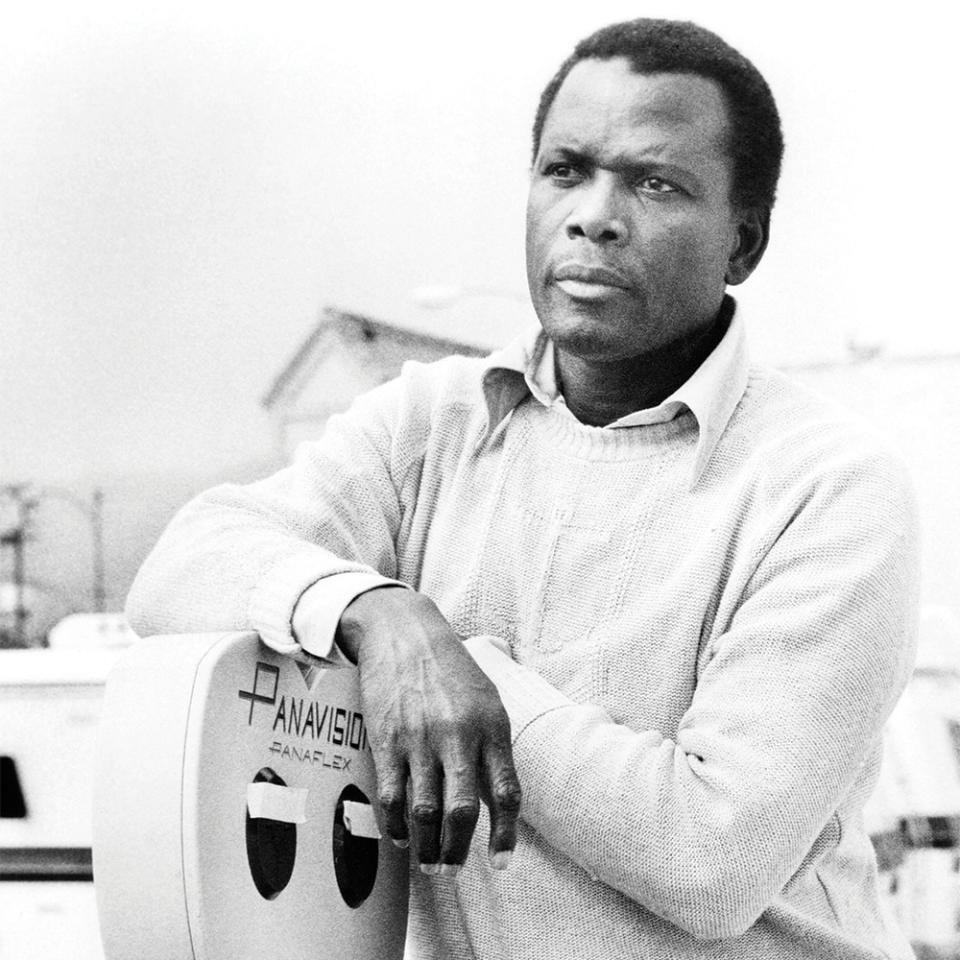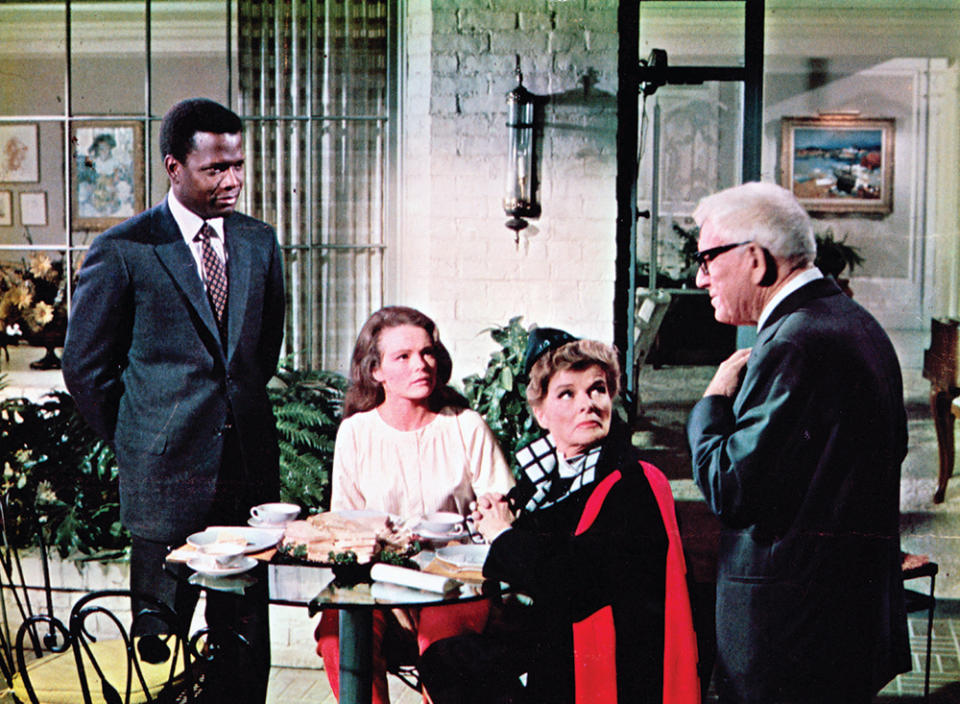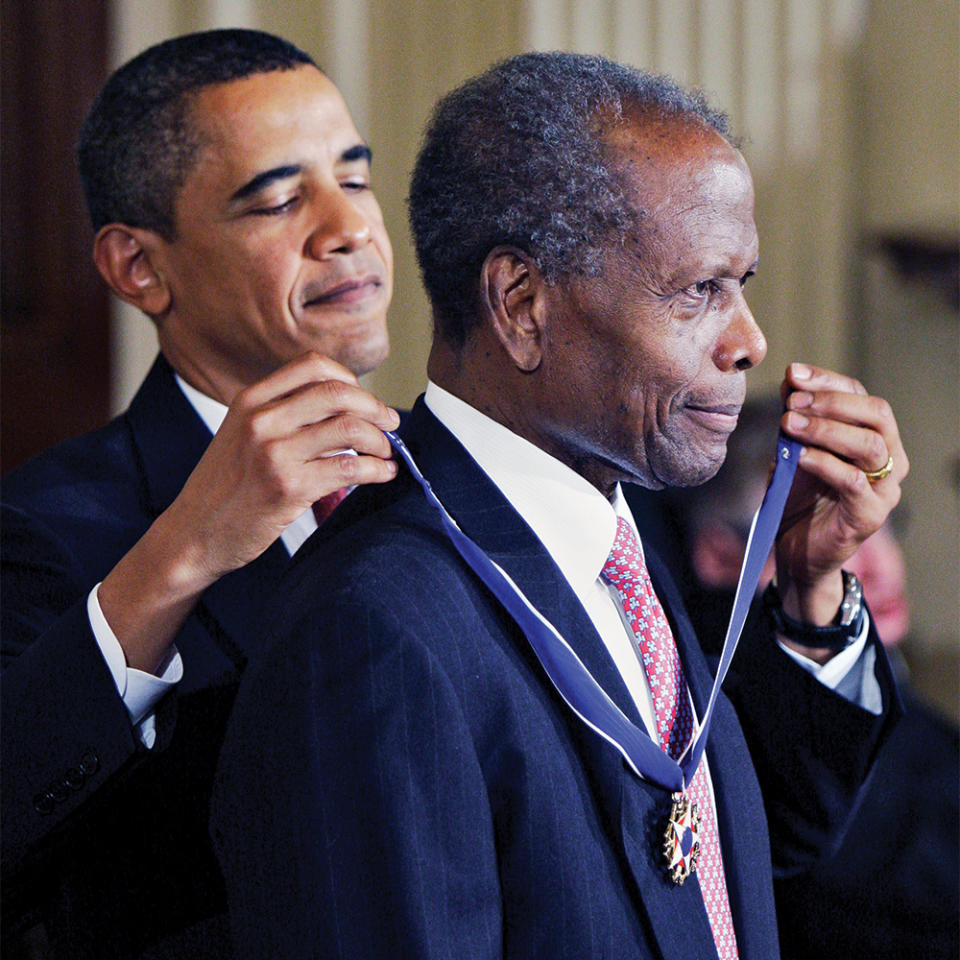Halle Berry Pens Tribute to Sidney Poitier: ‘An Angel Watching Over All Of Us’

I grew up idolizing Sidney Poitier.
I was around 9 when he flickered into my world on a television replay of “Guess Who’s Coming to Dinner.” I was a latchkey kid in Cleveland, daughter of a white, single mother and a Black father — whose union their parents had frowned upon. In the film, Sidney and his co-star, Katharine Houghton, play an interracial couple whose parents also struggle with their children’s relationship. There I sat in front of my mom’s old console, mesmerized, as I watched my family’s dynamic play out. For the first time in my childhood, I felt seen. Understood. Validated. The world already knew Sidney, who died last week at 94, as a formidable performer. But I first experienced him as a mirror.
More from Variety
Sidney Poitier Was as Committed a Humanitarian as He Was an Actor
Sidney Poitier's Daughter Remembers His Magic, Strength and 'Terrible Dad Jokes'
Why Sidney Poitier Was a Pillar of the Civil Rights Movement

AP Photo
I watched that film over and over again, through my middle-school years and beyond. By then, my mother had moved our family from a Black enclave in Cleveland’s inner city to the suburbs, where I became one of a few Black students in a sea of Caucasian faces. I was a child who, like my parents’ interracial relationship, never quite fit in. In those years, it was rare to see Blacks in leading roles, much less have our narratives celebrated or even acknowledged. Cicely Tyson and Diana Ross were on the scene, as was the fresh memory of Dorothy Dandridge, the Black actress I idolized as much as I did Sidney. Back then, their mere presence was itself a form of protest. A challenge to the notion of whiteness as humanity’s high-water mark. Still, those images were scarce. As a child born to a white woman and a Black man, I felt alone and misunderstood. “Guess Who’s Coming to Dinner,” as great art does, was an affirmation that I mattered. Also, it gave others a window into my reality, of what it felt like to navigate the world with both Black and white parents.
Sidney’s impact on me did not end there. Over the years, I looked to him as a sterling example, as a template of manhood and all that is honorable. I was just 4 when my parents separated, when my father’s alcoholism upended our family. As imperfect as my dad was, as deep of a wedge as his fury drove between us, I loved him, missed him, longed to have him close. In my mind’s eye, and in my father’s absence, Sidney epitomized what a man should be: unflappable and courageous, eloquent and proud, charming and handsome. He even physically resembled my father. I wasn’t yet born in 1964 when Sidney became the first Black man to win an Academy Award for best actor for his role in “Lilies of the Field.” But years later, when I witnessed the moment in a Black History class, I could not look away. Sidney’s grace and poise, the intention with which he spoke, the dignified way he carried himself — all of it resonated with me. Though I hadn’t met him, and did not dream that I ever would, I felt strongly connected to him.
That connection has followed me through my career. Nearly 40 years later when I began work on “Bruised,” my foray into directing, I was inspired by Sidney. He was brave. He took chances. He was a fighter. He demanded respect, just as his character once had when he confronted a white man in the 1967 film “In the Heat of the Night.” In the film, Sidney plays Philadelphia police detective Virgil Tibbs. When a plantation owner named Mr. Endicott (Larry Gates) slaps Virgil, Sidney’s character immediately slaps him back, and he does not wince when he does so. That scene became a defining moment for Black people everywhere, and it was an exchange Sidney insisted be included in the movie.

?Columbia Pictures/Courtesy Eve
“There were some flaws in the script that had to be corrected,” Sidney said in an interview. “I felt certain things were not appropriate in terms of the reality of the times.” He told the film’s producers: “In my life, whether I’m a detective or not, and I don’t care where I am, if such a thing happened to me, the likelihood is I would respond. And my response would certainly not be to absorb it.” That was not designed to be a big social comment. It was an actor’s note based on a man’s humanity. Like the character he played, Sidney simply would not allow himself to be diminished. His courage unleashed in me a sense that I, too, could stand in my power. I, too, could refuse to be diminished and perform the kinds of roles that I desired. On my own terms.
Sidney’s journey to Hollywood was more unlikely than my own. He grew up on Cat Island in the Bahamas as the youngest child of impoverished tomato farmers. At the age of 15, and with just three dollars in his pocket, he moved to New York. With little formal education, he eked out an existence as a dishwasher and ditch digger while teaching himself to read. He eventually spotted an ad from the American Negro Theatre in Harlem and auditioned to become part of the company.
Because of his thick Caribbean accent, however, he was turned away. That rejection did not dampen his resolve, but instead strengthened it. Sidney purchased a radio and began mimicking the pronunciations of American newscasters. When he returned to the theater’s acting school, volunteering to work as a janitor, he finally secured his spot. His break came in 1946 when Harry Belafonte, another student at the school, missed a rehearsal attended by a Broadway producer. In stepped the determined Sidney, who was eventually cast as Probulos in “Lysistrata.” That role opened the door for his illustrious body of work to follow, including “The Defiant Ones,” ”A Raisin in the Sun” and “To Sir, With Love.”

Everett Collection / Everett Col
Sidney also directed nine films. In fact, though he is widely applauded for his scores of searing portrayals, his work behind the scenes was as important as his on-screen work. It served as a blueprint for future filmmakers, for Black people who yearned to demonstrate their value on both sides of the camera. At a time when it was completely unheard of for a Black person to direct, Sidney defied expectations and forged ahead, directing “Stir Crazy,” the third-highest-grossing film of 1980, behind “The Empire Strikes Back” and “9 to 5.” It was the first film with a Black director to earn $100 million at the domestic box office. In so doing, Sidney created an opening for me and other filmmakers to follow. He did more than blaze a trail, he cleared a forest.
Sidney selected his roles carefully. In a nation that routinely demonized Blacks both on-screen and off, and in a media landscape that showed little respect for our humanity, he knew he did not have the luxury of playing characters that would further denigrate us. “It’s a choice, a clear choice,” he once said in an interview. “If the fabric of the society were different, I would scream to high heaven to play villains and to deal with different images of Negro life that would be more dimensional. But I’ll be damned if I do that at this stage of the game.” For that stance, and as the civil rights movement took a more defiant turn in the late 1960s, he received criticism even from some in his own community. Yet I respected his choices. He intended to present our people with the same dignity he strode through the world with. He relied only on his own moral compass, on his own sense of how to best use his gift. “I did not go into the film business to be symbolized as someone else’s vision of me,” he once said. His artistic choices were his way of raising his voice.
Years after I admired Sidney from afar, I met my idol in person. I was at work on the 1999 HBO film “Introducing Dorothy Dandridge,” the story of another trailblazer who made history when she was nominated for an Oscar. I’d arranged to interview him, to glean what I could about Sidney’s memories of Dorothy, as well as to hear what it was like to be Black in Hollywood during a time when there was little place for us in the industry. I greeted Sidney, eyes dancing, cheeks lifted — and then I froze. It is the only time in my life when I have been rendered speechless! I was so overwhelmed by his powerful presence, his regal aura, I could not get my words out. For several minutes, I just sat there and stared at him.

Courtesy Everett Collection
Being the gentleman that he was, Sidney took the lead in our exchange until I regained my composure and managed to speak. With his warm manner, with the same grace he displayed on-screen across the decades, he put me at ease. He shared how he and Dorothy felt an instant kinship. He connected to her sense of honesty and vulnerability, said he viewed her as a fawn in need of protection. He also felt she’d been robbed of an Oscar for her lead role in “Carmen Jones.” “As Black people,” he told me, “we must learn to swallow it bitter and spit it sweet” — a phrase I’ve clenched tightly throughout my career. Sidney understood how often artists of color are overlooked, how our talent is so frequently discounted. He did not let that reality define him. At the end of our two-hour meeting, I left with my head held high and my chest poked out because he paid me the highest compliment. “I can’t imagine anyone other than you bringing my dear friend Dorothy to the screen,” he said. “You embody the essence of who she was.” It is a conversation I will forever treasure.
A few years later, my tongue got tied yet again when I saw Sidney at a gala. He was seated at my table alongside his wife Joanna. I glanced over at him and … Could. Not. Move. In an attempt to calm myself and restore my voice, I began talking with Joanna. Once I found my confidence, I told Sidney how much he meant to me. “You look like you could be one of mine,” he quipped, noting what he saw as my resemblance to his daughters. I realized then that, whenever I’d see Sidney, my knees would weaken and my words would vanish. That is just how important he was in my world. He wasn’t just America’s first Black film hero. He was nobility and class personified.
In 2002, nearly 40 years after Sidney accepted his Academy Award, I took my place in the Kodak Theatre for the Oscar ceremony. On that evening, Sidney, who was seated in the balcony with his family, was to be presented with an honorary Oscar. I thought that would be the highlight of the event. I’d been nominated for my role in “Monster’s Ball,” but I truly did not believe I would win. My family seemed to feel the same. “No matter what happens,” they told me, “you’ve already won. Nobody can take this moment away from you.” Deep down they felt as I did, that some other name would be called. In fact, I’d already made peace with that. My fellow nominees were all so talented that if any of them had earned the gold, I would not have felt robbed.

ASSOCIATED PRESS
I was so persuaded one of them would win, I didn’t even prepare a speech. When Russell Crowe, red envelope in hand, uttered the phrase, “And the Oscar goes to … Halle Berry, ‘Monster’s Ball,’” I sat frozen, my body stuck in that seat, my spirit floating somewhere above me. “Get up, get up, you gotta get up!” my manager urged me. I don’t even remember walking up to the stage, nor do I recall the rapturous applause. My first memory is seeing Denzel Washington stand up. My next memory is hearing Russell say in my ear, “Breathe, mate. Breathe!” In the absence of a written speech, my subconscious came pouring forth, a mix of gratitude and astonishment, a recognition of those who’d paved my way — just as Sidney had.
As I concluded my rambling speech I looked up and saw dear Sidney, high in the balcony seemingly with a halo surrounding him, looking over me as a proud father would. Our paths had crossed all those years earlier when I, wide-eyed and frizzy-headed, watched him in awe from my living-room sofa. Decades later in that arena, our lives became inextricably connected — he, the first Black man to garner a leading-man Oscar, and I, the first Black woman to accomplish the same in my category. I was as tongue-tied in that moment as I was when I’d initially met him, as moved as I still am when I watch his films. History will remember Sidney as a giant of the screen, a legendary actor and director, a performer whose enormous talents were eclipsed only by his kindness. I will recall him as my first mirror, and the true measure of a man — and I will forever see him as the angel in the balcony watching over all of us.
Halle Berry is an Oscar-winning actor, director and activist.
Best of Variety
Sign up for Variety’s Newsletter. For the latest news, follow us on Facebook, Twitter, and Instagram.
